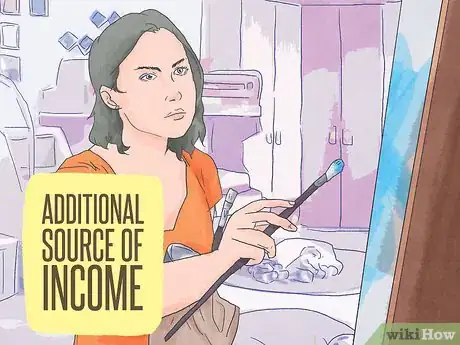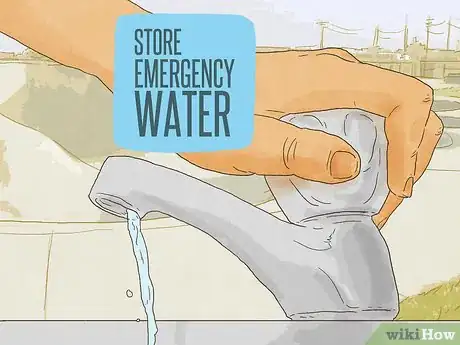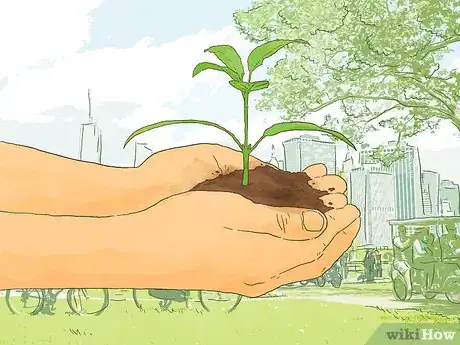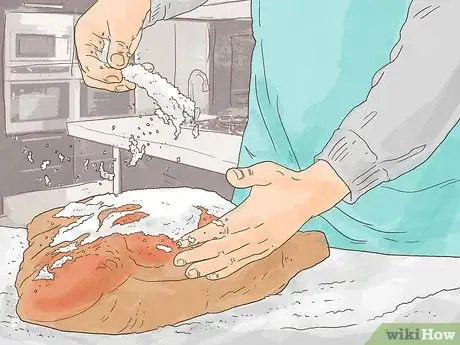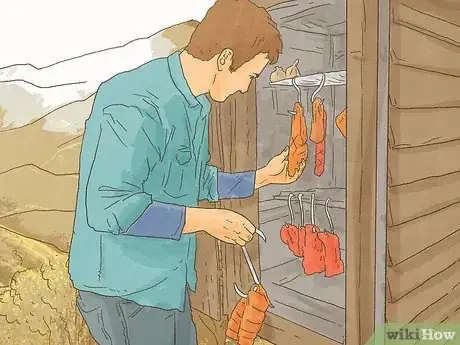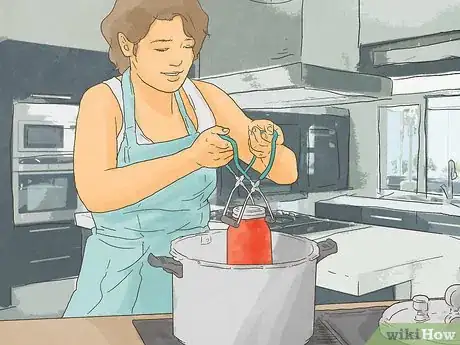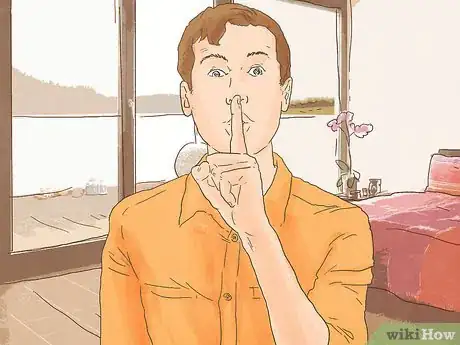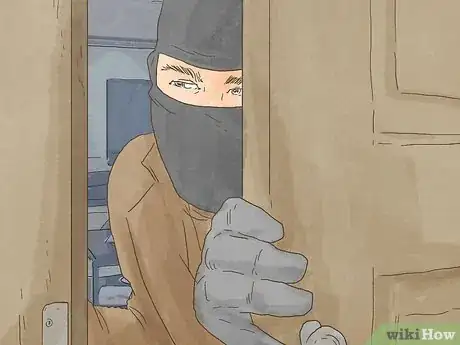This article was co-authored by Trent Larsen, CFP®. Trent Larsen is a Certified Financial Planner™ (CFP®) for Insight Wealth Strategies in the Bay Area, California. With over five years of experience, Trent specializes in financial planning and wealth management as well as personalized retirement, tax, and investment planning. Trent holds a BS in Economics from California State University, Chico. He has successfully passed his Series 7 and 66 registrations and holds his CA Life and Health Insurance license and CFP® certification.
There are 28 references cited in this article, which can be found at the bottom of the page.
wikiHow marks an article as reader-approved once it receives enough positive feedback. In this case, 100% of readers who voted found the article helpful, earning it our reader-approved status.
This article has been viewed 283,475 times.
An economic collapse means a breakdown of the national economy. It would be characterized by a long-term downturn in economic activity, increased poverty and a disruption of the social order, including protests, riots and possibly violence.[1] In some cases, this collapse would be akin to a deep recession, with society still functioning basically as normal (just with more poverty). However, it could be much worse. You should prepare for the worst, but adjust your actions to the actual severity of the collapse. You can prepare for an economic collapse by preparing financially, stocking up on the essentials, and monitoring the economic indicators.
Steps
Preparing Your Finances
-
1Start an emergency fund.[2] If you are living paycheck to paycheck and you lose your job during an economic collapse, you are at risk for losing your home and living in poverty. It won’t be easy to find another job and replace your income. Your goal should be to save up enough to cover six months of expenses in your emergency fund.[3]
- If you are trying to get out of debt, save up an emergency fund of $1,000 and then apply all of your extra income to your debt. Once your debt is paid off, you can divert more money into your emergency fund.[4]
- Keep your emergency fund separate from your checking account so that you are not tempted to use the money. Put it in a low-risk, interest-bearing account such as a savings account, money market account or certificate of deposit (CD).[5]
- On the other hand, a complete economic collapse would leave you unable to access your bank account, because of the crash of the financial system. Additionally, your money may become useless or extremely devalued. Consider stocking other commodities that you could barter with in an economic collapse, like alcohol, precious metals (gold and silver), and fuel.
-
2Have cash on hand. Depending on where you have it, money in your emergency fund might be hard to liquidate. Bonds, for example, must be sold, and other investments like CD’s might charge fees for early withdrawal. Also, if you have a savings account with an online bank instead of a brick-and-mortar institution, it might take several days to withdraw your money. It’s important to have cash that you can access easily, either from a savings account or a cash box in your home. This can tide you over in an emergency until you can access money in your emergency fund.[6]Advertisement
-
3Generate an additional source of income. Start a home business as a second source of income. If you lose your job because of an economic collapse, it might be difficult or even impossible to find another job. Having an alternative source of income can help you to keep your home and avoid poverty.[7] Choose your business idea based on skills that you have and things that you enjoy doing. In addition, think about how likely it will be that people will require these services in an economic collapse; people may need basic necessities like clean water or food more than they need an interior decorator.[8]
-
4Get out of debt. In a financial collapse, many people are going to lose their jobs and their homes. To prepare for this possibility, you should make a plan to get out of debt as quickly as possible. This way, if you do lose your job, you don’t have to worry about finding a way to pay these bills. The worst kind of debt to have is credit card debt. Because of the high interest rates that many people have, carrying a balance on a credit card can cost you a great deal of money.[11]
- Create a budget in order to track your income and expenses.[12] Make a plan to have a surplus of money left over at the end of the month to apply towards your debt. This means reducing your expenses and possibly finding additional work to supplement your income.[13]
- Organize your debt so you can make a plan to pay it off. You can choose from a few different methods for planning how to pay off your debt. Whichever method you choose, it is important to stick with it.[14]
- One method is to order your debts from smallest to biggest, regardless of the interest rate, and pay off the smallest debts first. This helps you build momentum.[15]
- Another method is laddering, which means paying off the debt with the highest interest rates first. This makes the most sense mathematically because it reduces the amount of interest expense you pay in the long-term.[16]
- That said, in a true economic collapse, your creditors would likely have other things to worry about than just finding you and recovering your debts. Additionally, currency may be greatly devalued or completely useless, meaning that the amount stated on your debt balance would be equally depressed or meaningless.
Storing the Essentials
-
1Store emergency water. In the event of an economic collapse, it is possible that your power and water supply might be interrupted, or that you will not be able to pay for these things. You will need a supply of clean water for drinking, cooking and hygiene. You can purchase bottles of water or store water in your own containers. If you run out of water, you can take steps to sanitize contaminated water.[17]
- Store at least one gallon of water per person for a minimum of three days or for up to two weeks. Don’t forget to include pets in this equation.
- If you are storing water in your own containers, wash them first with dish soap and water and sanitize them with a solution of 1 teaspoon of liquid chlorine bleach to a quart of water.
- To make water safe, you can boil it and filter it through a clean cloth, paper towel or coffee filter[18]
-
2Stockpile food. The kind of food you store up for an emergency is different from the groceries you purchase each week. You need to get food that is non-perishable, does not have to be refrigerated and will provide you with the nutrition you need to survive. It may be very different from the food you are used to eating, but you will be glad you have it if you ever need it.[19]
- Purchase food that does not have to be refrigerated or frozen so you don’t have to worry about power outages. These foods include canned goods, peanut butter and beef or turkey jerky.
- Include foods highly nutritious foods that are easy to store, such as dried foods, nuts, beans, canned meat and vegetables and powdered milk.
- For comfort foods, avoid snack foods that will quickly expire. Instead, stock up on spaghetti and spaghetti sauce, soups, sugar and honey for canning and baking, dried fruit, coffee and tea and hard candy.
- If necessary, stock pile baby food and formula.
- Don’t forget to include pet food if you have pets.
- Keep a manual can opener with your stockpile.
-
3Start a garden. A garden allows you to continually have fresh, nutritious food to supplement your emergency food supply. Also, in an economic crisis the cost of living might skyrocket. Having a garden will help you to save money on your grocery bills. It will also allow you to be self-sufficient should a food shortage result from the financial collapse.
- If you don’t have a lot of space, consider starting a container garden.
- If you don’t have good soil, purchase humus soil or top soil. Add peat moss, composted manure and plant fertilizers.
- Choose vegetables and herbs that are easy to grow, including beans and peas, carrots, greens like lettuce, cabbage, spinach and kale, potatoes and sweet potatoes, squash, tomatoes, broccoli, berries and melons.
-
4Create an emergency kit. This is a collection of household items you might need in an emergency. In the event of an economic collapse, you may not be able to shop for these supplies, so it’s important to have them on hand. Keep your supplies in a container that’s easy to carry in case you have to evacuate for some reason. [20] [21]
- Include an extra set of car keys, blankets, matches, a multi-use tool, maps of the area, a flashlight, a battery-powered or hand-cranked radio, extra batteries, matches and a cell phone and chargers.
- Have some household liquid bleach on hand for disinfecting.
- Make copies of all important documents, such as proof of address, deed/lease to home, passports, birth certificates and insurance policies.
- Have a list of family and emergency contact numbers.
- Include baby supplies such as baby food, formula, diapers and bottles.
- Remember pet supplies like food, collars, leashes and food bowls.
-
5Gather first aid and medical supplies. You can purchase a first aid kit or put one together yourself. Either way, make sure it has all of the necessary supplies. Include personal items such as medications for yourself and members of your family. Check the kit regularly to make sure nobody has used any of the supplies. Also, check the expiration dates and replace expired items.[22]
- Keep a first aid manual with your first aid kit.
- Include dressings and bandages, such as adhesive bandages in various sizes, sterile gauze pads and a gauze roll, adhesive tape, elastic bandages and sterile cotton balls.
- Add equipment and other supplies, like latex or non-latex gloves, instant cold packs, a thermometer, safety pins to fasten splints or bandages, tweezers, scissors and hand sanitizer.
- Have medicines for cuts and injuries, such as antiseptic solution like hydrogen peroxide, antibiotic ointment, calamine lotion for stings or poison ivy, hydrocortisone cream for itching and an eyewash solution.
- Include contact lens solution if necessary.
- Other medicines to have include pain and fever medicines like aspirin, acetaminophen or ibuprofen, antihistamines for allergies, decongestants for colds, anti-nausea medicine, anti-diarrhea medicine, antacids and laxatives.
Preserving Food
-
1Preserve meat and fish. In an economic collapse, food stores could become dangerously low. If you are going to stock up on meat and fish ahead of time, you will need to know how to cure it. This will allow it stay fresh and edible much longer. Also, it can be stored at room temperature. This will be helpful in the event of a power outage.[23]
-
2Salt cure meat. Salt curing means using salt to kill the microbes that would spoil it. For every 100 pounds of meat, you need 8 pounds of salt, 2 ounces of saltpeter and 3 pounds of sugar. Apply the cure mixture directly to the meat. For bacon, allow the meat to cure for 7 days per inch of thickness. For ham, leave the mixture on for a day and a half per pound. After curing, rub off the salt under running water and allow it to dry.
- If the outdoor temperature is expected to rise above 40 degrees Fahrenheit, you will need to allow the meat to cure in a meat locker.
- If the outdoor temperature is below freezing, allow an extra day for curing.
-
3Smoke cure meat. Wood smoking meat not only adds flavor, but it also protects your meat from pests and spoilage. Cold smoking smokes the meat without cooking it. Hang the meat in a smoke house, light the fire and allow the meat to smoke for 10 to 20 hours. You can purchase a ready-made smoke house or plans to build your own.[24]
- Use aromatic woods to add flavor, such as hickory, mesquite, apple, cherry, pear or cranberry-apple.
- Woods to avoid include all conifers, crape myrtle, hackberry, sycamore and holly.
-
4Jerky meat. To make meat jerky, you can use a store-bought dehydrator. However, if you do not have one of those, you can do it in your oven by cooking it at a low temperature for several hours. Choose an inexpensive cut of meat, such as brisket. Trim the fat and slice thin strips against the grain. Season the meat with salt and pepper, and if desired, marinate it overnight with diluted barbecue sauce. Arrange the slices on a cooking grate, and put them in the oven at 170 degrees Fahrenheit for two to six hours.[25]
- Line your oven with foil for easy cleanup.
- Prop the oven door open with a wooden spoon to allow air to circulate.
- Partially freeze meat before slicing to make it easier to slice.
-
5Can fruits and vegetables. Canning involves heating food in a glass jar to remove the air and prevent spoilage. Choose from two methods to can food: water bath and pressure canning. The method you choose depends on the kind of food you want to can. Water bath canning is for jams, jellies and for acidic foods such as tomatoes, berries or cucumbers in vinegar. For main meal foods such as meat, beans and other vegetables, use pressure canning. To ensure safety, always use tried and true recipes.[26] [27]
-
6Can with the water bath method. Gather a deep pot with a lid, a rack that fits into the pot, glass preserving jars, lids and bands and a jar lifter. Check the jars and lids for nicks and scratches which would prevent proper canning and allow spoilage to occur. Heat the jars in a pot of boiling water or in the dishwasher. Prepare your recipe and fill the hot jars with the food. Place the lids on the jars and immerse them in boiling water. Make sure the water covers the jars by 1 to 2 inches. Leave them in the water for the amount of time stated in the recipe. Remove the jars with a jar lifter and allow them to sit for 12 to 24 hours.[28]
- The lids should not flex up and down when pressed. If they do flex or if you can easily remove the lid, then the jar did not seal properly.
-
7Can with pressure canning. You will need a store-bought pressure canner. As with water bath canning, check the jars for nicks and scratches, and heat them in boiling water or the dishwasher. Prepare the food according to your recipe and fill hot jars with the food. Place the jars in the canner and lock it in place. Vent the steam according to the manufacturer’s directions. Process the jars at the recommended pounds pressure stated in your recipe. Adjust for altitude. When done, remove the jars, allow them to sit for 12 to 24 hours and check the seals.
Securing Your Home
-
1Choose your shelter type. A standalone shelter is a separate building that is designed to withstand natural disasters or man-made weapons or attacks. An internal shelter is a room within your home that has been designed to protect you from the elements or other hazards. In an economic collapse, power systems may fail and looters and scavengers may threaten your home. Take precautions to protect yourself.[29]
-
2Create two sources of electricity. One source could be solar. Hook it up to your home and then run the system discretely underground. The second source might be an underground generator. You will use this in the event of a total loss of power. Keep your energy sources hidden underground to protect them.
-
3Choose the size of your shelter. The size of your shelter depends on how many people you need to protect and the size of your food stockpile. An adult needs 10 cups of water and 1,200 calories per day. In addition, each adult needs 10 cubic feet of natural atmosphere to have enough air to breathe, so you will need an air system that lets in and filters fresh air. If you are planning to stay in the shelter long-term, invest now in making it large and comfortable enough for everyone. If it is only going to be a short-term living space, you don’t have to make it as comfortable.
-
4Keep the location of your shelter secret. Protect yourself from others who were not prepared and may want to take what you have. Don’t let your neighbors see you creating a shelter. You can choose a remote location, but it may be difficult to access it later. If you choose to make a safe room in your home, create a secret entrance from within your house. This way others will not be alerted to your shelter.
-
5Purchase self-defense tools. Self-defense tools are generally non-lethal. They are used to fend off an attack by rendering the attacker ineffective. You can use everyday objects, such as baseball bats or keys. But these may not be as effective as tools designed for your protection.
- Mace and pepper spray can be sprayed into an attacker’s face to give you time to get away.
- Hand-held stun guns deliver a large electrical shock to stun the attacker.
- Taser devices shoot two small probes a distance of up to 15 feet that transmit an electrical charge to the attacker.
- Sonic alarms create a loud noise to let others know that you are in trouble.
-
6Set up an alarm system in your home. Wireless security systems are easy and inexpensive to install and maintain. Home alert alarm systems notify you if an intruder is approaching your home. Hidden cameras allow you to see internal and exterior areas in your home where an intruder may be present. Phone dialing alarms can be installed inside or outside your home and allow you to contact authorities with the push of a button. Child monitoring alarms notify you if your child goes beyond a certain perimeter of your home.
-
7Purchase weapons. Weapons can be used for either self-defense or for hunting. A crossbow is easy to shoot and aim. It’s also quiet, so it doesn’t alert people or animals to your presence. A long-range rifle allows you to hunt game from a distance. A machete can clear brush or fend off a dangerous animal. A slingshot is good for hunting small animals. Have pistols on hand and teach others to shoot, reload, shoot from cover and work as a team for protection. If you plan to have lethal weapons, be sure to train everyone who has access to them in the proper use of these weapons.[30]
- Stockpile appropriate ammunition and arrows for your weapons.
-
8Gather necessary tools. Having the right tools on hand can make the difference between surviving and not surviving during any kind of disaster. You not only want to be able to protect your home, but you also need to be able to build anything you might need.
- Have a bolt-cutter on hand to cut through fences and wire.
- Picks, shovels, axes, chain saws and bow saws allow you dig and gather and cut wood.
- Rope and paracords are essential for assembling simple and complex survival systems.
- Tarps are necessary as ground covers or for weather-proofing.
- Stock pile nails and plywood for building and repairs.
- Keep large trash bags for waste disposal.
- Have gasoline for fuel or a fire starter.
- Get a propane stove for cooking.
- Have a fishing rod for catching fish.
Preparing Your Family
-
1Make sure everyone is aware of the situation. In order to prepare for economic collapse, you will have to make sure that your whole family is on board with your preparations. This means informing them in honest terms what is about to happen and telling them what they should be doing. Make sure everyone takes the situation seriously. Otherwise, they will not be mentally prepared in the event that economic collapse actually occurs.[31]
-
2Check that each family member is individually prepared. Inform each other family member of the steps you have taken to prepare your finances, essential supplies, food, and shelter. Instruct them on doing the same. Make sure each family member has also packed a bag of essentials that they can grab if they are forced to leave the house without notice. This bag should contain enough survival essentials to last between 72 hours and a week.[32]
-
3Train family members in survival skills. Your immediate family members should be aware of how to handle weapons safely, perform basic first aid, hunt or grow food, and maintain your shelter. If they don't already have these skills, take the time to instruct them thoroughly. You never know when you might have to depend on them.[33]
-
4Work with another family or group. In addition to your immediate family, consider including other family members, neighbors, or a community group (like a church group) in your preparations. Make sure that these are people who are reliable and will put in work for the benefit of the group. You will be safer and work more efficiently if you can increase the size of your group.[34]
Anticipating a Financial Crisis
-
1Monitor the financial markets. Calm markets tend to go up. But if the market gets choppy, meaning prices swing up and down considerably,[35] it will likely decline. Don’t be fooled if he market soars for one day. Big ups and downs in the markets are a red flag signaling an overall decline.
-
2Keep an eye on global 10 year bond yields. Global bonds are bonds that are issued in several countries at once by governments or large multi-national companies.[36] When 10 year global bond yields drop, it is in indicator that investors are withdrawing their money to put it in safer investments. This happened before the financial crisis that happened in 2008. A significant drop in 10 year global bond yields means that investors think a financial crisis is coming.[37]
-
3Pay attention to oil prices. The fluctuation of oil prices has a macroeconomic impact. When oil prices increase, the Gross Domestic Product (GDP) goes up too. The GDP is a quantitative measure of the nation’s total activity. If it is increasing, then the value of goods and services is also going up. If periods of high oil prices signal good times for the world economy, then the opposite is also true. If oil prices are on the decline, expect the GDP and the financial markets to also decline.[38]
-
4Understand the relationship between inflation and economic growth. Economic growth tends to lead to inflation. As demand increases, prices are driven up and unemployment falls. As unemployment falls, wages increase. As wages increase, people spend more, which leads to inflation of prices. Conversely, when economic activity slows down, so does inflation. Therefore, if the price of goods and services slows dramatically, it could signal a major downturn in the economy.[39]
-
5Monitor the price of commercial commodities. Commercial commodities are goods exchanged during commerce, such as gold, lumber, beef or natural gas.[40] Changes in the prices of commodities affect the United States economy and the value of the U.S. dollar. An increase in commodity prices is correlated with an increase in inflation. Increased inflation correlates with economic growth. However, if commodity prices drop, inflation slows, which indicates economic decline.[41]
Expert Q&A
-
QuestionWhat are common budgeting mistakes people often make?
 Trent Larsen, CFP®Trent Larsen is a Certified Financial Planner™ (CFP®) for Insight Wealth Strategies in the Bay Area, California. With over five years of experience, Trent specializes in financial planning and wealth management as well as personalized retirement, tax, and investment planning. Trent holds a BS in Economics from California State University, Chico. He has successfully passed his Series 7 and 66 registrations and holds his CA Life and Health Insurance license and CFP® certification.
Trent Larsen, CFP®Trent Larsen is a Certified Financial Planner™ (CFP®) for Insight Wealth Strategies in the Bay Area, California. With over five years of experience, Trent specializes in financial planning and wealth management as well as personalized retirement, tax, and investment planning. Trent holds a BS in Economics from California State University, Chico. He has successfully passed his Series 7 and 66 registrations and holds his CA Life and Health Insurance license and CFP® certification.
Certified Financial Planner The most common mistake right now is living beyond your means. For example, somebody who's making five grand a month might be spending six grand a month. A big component of that is that things are very expensive right now depending on the city you live in. With rent numbers so high in certain cities, you tend to have to spend a lot more than if you were living in the suburbs. When budgeting, the most important thing you can do is understand what you're spending your money on and make sure that you're not racking up credit card debt.
The most common mistake right now is living beyond your means. For example, somebody who's making five grand a month might be spending six grand a month. A big component of that is that things are very expensive right now depending on the city you live in. With rent numbers so high in certain cities, you tend to have to spend a lot more than if you were living in the suburbs. When budgeting, the most important thing you can do is understand what you're spending your money on and make sure that you're not racking up credit card debt.
References
- ↑ http://www.investopedia.com/terms/e/economic-collapse.asp
- ↑ Trent Larsen, CFP®. Certified Financial Planner. Expert Interview. 22 July 2020.
- ↑ http://beforeitsnews.com/self-sufficiency/2014/12/how-to-prepare-for-an-economic-collapse-2-2484496.html
- ↑ http://www.moneycrashers.com/start-build-emergency-fund-savings/
- ↑ http://www.moneycrashers.com/start-build-emergency-fund-savings/
- ↑ http://www.moneycrashers.com/start-build-emergency-fund-savings/
- ↑ http://beforeitsnews.com/self-sufficiency/2014/12/how-to-prepare-for-an-economic-collapse-2-2484496.html
- ↑ http://www.entrepreneur.com/article/201588
- ↑ http://www.entrepreneur.com/article/201588
- ↑ http://www.entrepreneur.com/article/201588
- ↑ http://beforeitsnews.com/self-sufficiency/2014/12/how-to-prepare-for-an-economic-collapse-2-2484496.html
- ↑ Trent Larsen, CFP®. Certified Financial Planner. Expert Interview. 22 July 2020.
- ↑ http://www.clarkhoward.com/how-get-out-debt-quickly-5-simple-steps
- ↑ http://www.clarkhoward.com/how-get-out-debt-quickly-5-simple-steps
- ↑ http://www.clarkhoward.com/how-get-out-debt-quickly-5-simple-steps
- ↑ http://www.clarkhoward.com/how-get-out-debt-quickly-5-simple-steps
- ↑ http://emergency.cdc.gov/preparedness/kit/water/
- ↑ http://www.cdc.gov/healthywater/emergency/safe_water/personal.html#make_safe
- ↑ http://www.offthegridnews.com/extreme-survival/25-must-have-foods-for-an-emergency-stockpile/
- ↑ http://www.ready.gov/build-a-kit
- ↑ http://www.redcross.org/prepare/location/home-family/get-kit
- ↑ http://www.redcross.org/prepare/location/home-family/get-kit/anatomy
- ↑ http://www.survivalnewsonline.com/index.php/2012/01/how-to-smoke-meat/
- ↑ http://www.survivalnewsonline.com/index.php/2012/01/how-to-smoke-meat/
- ↑ http://moderncaveman.org/projects/beef-jerky/how-to-make-beef-jerky.html
- ↑ http://www.motherearthnews.com/real-food/canning/home-canning.aspx
- ↑ http://nchfp.uga.edu/how/can_home.html
- ↑ https://www.ballmasonjars.com/water-bath-canning.html
- ↑ http://www.fema.gov/
- ↑ http://www.secretsofsurvival.com/survival/50-critical-items-to-survive-disaster.html
- ↑ https://www.wealthdaily.com/resources/surviving-the-coming-economic-collapse/34
- ↑ https://www.wealthdaily.com/resources/surviving-the-coming-economic-collapse/34
- ↑ https://www.wealthdaily.com/resources/surviving-the-coming-economic-collapse/34
- ↑ http://www.stevequayle.com/index.php?s=219
- ↑ http://www.investopedia.com/terms/c/choppymarket.asp
- ↑ http://www.investopedia.com/terms/g/globalbonds.asp
- ↑ http://www.zerohedge.com/news/2015-01-07/10-key-events-preceded-last-financial-crisis-are-happening-again
- ↑ http://oilprice.com/Energy/Oil-Prices/How-Closely-are-Oil-Prices-Tied-to-Economic-Activity.html
- ↑ http://www.economicshelp.org/blog/458/economics/conflict-between-economic-growth-and-inflation/
- ↑ http://www.investopedia.com/terms/c/commodity.asp
- ↑ http://www.nber.org/papers/w3158



